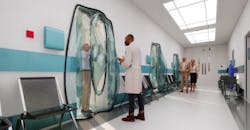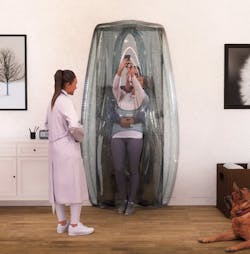WATG designs solution for isolating without sacrificing social connectivity
By David Malone, Associate Editor
“What’s a bubble boy?”
“He lives in a bubble!”
“…boy.”
Coronavirus has made Seinfeld bubble boys and girls out of many of us. But in an effort to make the transition to isolation easier, without the need to sacrifice human interaction, WATG has created Oriel, a new option that allows any room to become a self-isolation zone while maintaining a social component.
“Adhering to safe isolation typically means removing an individual entirely from socialization and communication with the outside world. Complete isolation can spark greater detriment to our health and overall well-being, but Oriel strikes a balance between keeping a safe distance while maintaining human connectivity,” said Daniel Caven, Global Technology Design Lead at WATG.
Inspired by oriel bay windows, the translucent and acoustically friendly barrier can be installed onto any doorway. Oriel is an extension of the clear glass doors or windows already found in many healthcare isolation rooms, allowing for privacy and maintaining droplet isolation, but improving interactions with people outside the room. Plastic sleeves built into the design allow for “contact” without people outside the room.
Model heights range from low, medium, and tall, and offer sleeves from low partial, low full, medium partial, and medium full. The sizes are suitable for children, teenagers, adults, and the elderly. Wheelchair accessible scenarios are also available.
Suitable for COVID-19, Oriel can also be used for patients with other communicable diseases or the immunosuppressed, and can be applied across home, apartment buildings, hospice care facilities, and healthcare facilities.

